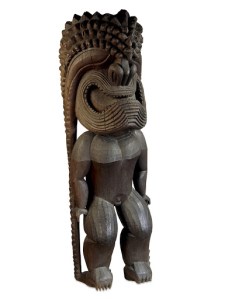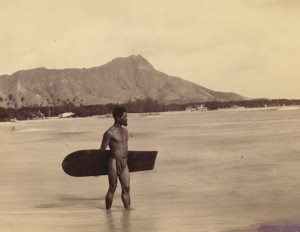I’ve never before heard of so many exciting reasons to visit the Bishop Museum. I dare you to not to mark at least one visit on your summer calendar.
 “This exhibition brings together the last of the great carved Kū images from across the world,” said Timothy Johns, president and chief executive officer of Bishop Museum, during the media preview conference on June 3, 2010. “It has been a dream of people for many years.”
“This exhibition brings together the last of the great carved Kū images from across the world,” said Timothy Johns, president and chief executive officer of Bishop Museum, during the media preview conference on June 3, 2010. “It has been a dream of people for many years.” Peabody Essex Museum Director and CEO Dan Monroe stated, “It is a pleasure to help it return to Hawai’i,” and explained their image has been traced to a Christian chief who was set on destroying it. It was sent to Massachusetts in 1842, where the sea captain John T. Prince stored it until the Museum took possession in 1846. “We are happy to have the opportunity to preserve and protect him, an artistic masterpiece that reflects the artistic genius of native Hawaiians.”
The British Museum’s Keeper of the Department of Africa, Oceania and the Americas, Jonathan King stated, “This is a wonderful and exceptional project we hope will be the first of many with the Bishop Museum and native Hawaiians,” then went on to explain what they know about their image, which they think came to London during King Kalakaua’s 1820 visit. He also noted that all of their mouths are carved very similarly, and generally exhibit such confident stokes even though the tools were likely not in use very long.
Bishop Museum Information about the three Kū:
- Temple Image, Bishop Museum: March 1895, made part of the Museum’s permanent collections through a purchase made by Charles Reed Bishop
- Temple Image, Peabody Essex Museum, Salem: Gift of John T. Prince in 1846. Sea Captain John T. Prince presented the 800 pound idol to the East India Marine Society (which later became the Peabody Museum)
- Temple Image, The British Museum: Gift of W. Howard in 1839
- **See them together in my very grainy photo below
3) And on June 19th, the Museum launched a new exhibit of historic surfboards and surfing images culled from their collection of historic Hawai’i photos–the largest such archive around.
 SURFING: Featuring the Historic Surfboards in Bishop Museum’s Collection runs through September 6, 2010, and features such highlights as more than 25 historic surfboards (including some once belonging to ali’i), a surf simulator so visitors can try surfing right in the museum halls, examples of board design through modern times, and historic photos like this one from the archives.
SURFING: Featuring the Historic Surfboards in Bishop Museum’s Collection runs through September 6, 2010, and features such highlights as more than 25 historic surfboards (including some once belonging to ali’i), a surf simulator so visitors can try surfing right in the museum halls, examples of board design through modern times, and historic photos like this one from the archives.
“Surfing is worldwide, but its roots are in Hawai‘i. From its island home, the sport has spread internationally in the last one hundred years. As surfing has grown so has the interest in its history,” said Library and Archives Collection Manager DeSoto Brown.
Go, visit, learn–then tell me what you think.


